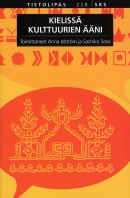Tag: language
Turd i’ your teeth
24 November 2011 | This 'n' that

Swearwords: universal language? Picture: Wikimedia
The title is a phrase by Shakespeare’s contemporary Ben Jonson, used in his plays.
In Japanese, swearwords are unknown. The worst thing you can say to a member of the African Xoxa tribe is ‘hlebeshako’, which roughly translates as ‘your mother’s ears’. ‘Swearing involves one or more of the following: filth, the forbidden and the sacred,’ says the American-born journalist and author Bill Bryson in his book Mother Tongue. The Story of the English Language (1990). It is a very entertaining and enlightening work full of interesting facts and peculiarities, many of them about a languages other than English.
There is one faulty reference to the Finnish language, though, and we do wonder how it has got into the book:
‘The Finns, lacking the sort of words you need to describe your feelings when you stub your toe getting up to answer a wrong number at 2.00 a.m., rather oddly adopted the word ravintolassa. It means “in the restaurant”.’ (p. 210)
Indeed it does, and definitely we never did. Adopt, that is. We’ve never ever heard anyone substituting a solid swearword – and there is no lack of sustainable, onomatopoeically effective (lots of r’s) examples in the Finnish language – for ‘ravintolassa’. Darn! Any Finn (prone to cursing) would say PERRRKELE, for example.
Someone, we fear, has been having Mr Bryson on.
Vesa Heikkinen & Harri Mantila: Kielemme kohtalo [The fate of Finnish]
14 October 2011 | Mini reviews, Reviews
 Kielemme kohtalo
Kielemme kohtalo
[The fate of Finnish]
Helsinki: Gaudeamus, 2011. 235 p.
ISBN 978-952-495-188-3
€ 32, paperback
This book sets out to examine the reasons behind concerns about the decay of the Finnish language. The authors maintain that linguistic immutability is too often taken to be a synonym for ‘good’ language, even though a living national language is capable of picking up new influences all the time without being in danger of destruction. The factor which the authors consider to be the greatest threat to Finnish is not youth slang, global English, or immigration but Finglish, the practice of using a mixture of Finnish and English, which has become widespread in research, commerce and government. The names of companies and public bodies are changed into opaque English-language abbreviations. Linguists are also concerned by the bureaucratisation of language that is often linked with public-sector reforms. Increasing linguistic inequality is the most serious threat described in this book: in the worst-case scenario, children’s and young people’s poor skills in Finnish could increase the gaps between classes in society and give rise to a growing mass of the excluded alongside an elite who are well-versed in the nuances of the language.
Translated by Ruth Urbom
Kielissä kulttuurien ääni [Language: the voice of cultures]
22 February 2010 | Mini reviews, Reviews
 Kielissä kulttuurien ääni
Kielissä kulttuurien ääni
[Language: the voice of cultures]
Toim. [Ed. by] Anna Idström and Sachiko Sosa
Helsinki: Suomalaisen Kirjallisuuden Seura, 2009. 311 p.
ISBN 978-952-222-129-2
€ 28, paperback
It is estimated that at least half of the world’s languages are dying out. This book aims to provide readers with information on the relationship between languages and cultures. What sorts of human cultural traditions are disappearing as a result of language extinction? In this book, linguistic researchers describe aspects of the interplay between language and culture and how different languages shed light on the cultures of their speakers. The 15 chapters include studies of the special features of Khanty texts, the Mansi language of Russia, Bantu languages, Creoles and Japanese as well as of language taboos within Finnish Roma culture. The subject is also addressed via translation studies; translating the Bible into hundreds of languages has proved that every language is unique – no language is completely substitutable for another in all its finest nuances.

